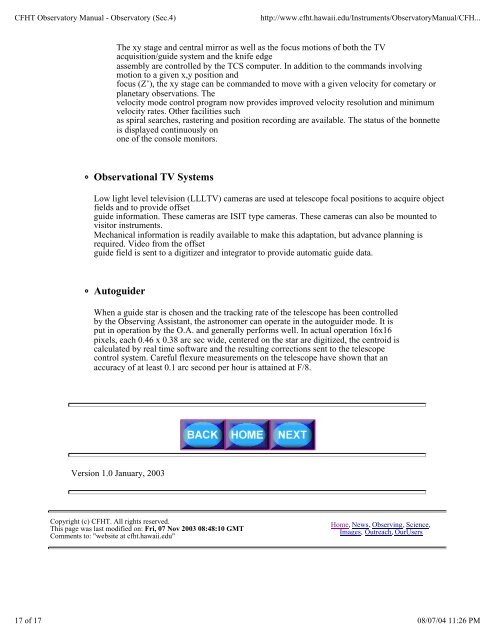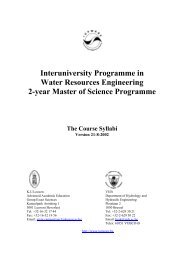CFHT operating manual - Homepage Usask
CFHT operating manual - Homepage Usask
CFHT operating manual - Homepage Usask
You also want an ePaper? Increase the reach of your titles
YUMPU automatically turns print PDFs into web optimized ePapers that Google loves.
<strong>CFHT</strong> Observatory Manual - Observatory (Sec.4) http://www.cfht.hawaii.edu/Instruments/ObservatoryManual/CFH...<br />
The xy stage and central mirror as well as the focus motions of both the TV<br />
acquisition/guide system and the knife edge<br />
assembly are controlled by the TCS computer. In addition to the commands involving<br />
motion to a given x,y position and<br />
focus (Z’), the xy stage can be commanded to move with a given velocity for cometary or<br />
planetary observations. The<br />
velocity mode control program now provides improved velocity resolution and minimum<br />
velocity rates. Other facilities such<br />
as spiral searches, rastering and position recording are available. The status of the bonnette<br />
is displayed continuously on<br />
one of the console monitors.<br />
Observational TV Systems<br />
Low light level television (LLLTV) cameras are used at telescope focal positions to acquire object<br />
fields and to provide offset<br />
guide information. These cameras are ISIT type cameras. These cameras can also be mounted to<br />
visitor instruments.<br />
Mechanical information is readily available to make this adaptation, but advance planning is<br />
required. Video from the offset<br />
guide field is sent to a digitizer and integrator to provide automatic guide data.<br />
Autoguider<br />
When a guide star is chosen and the tracking rate of the telescope has been controlled<br />
by the Observing Assistant, the astronomer can operate in the autoguider mode. It is<br />
put in operation by the O.A. and generally performs well. In actual operation 16x16<br />
pixels, each 0.46 x 0.38 arc sec wide, centered on the star are digitized, the centroid is<br />
calculated by real time software and the resulting corrections sent to the telescope<br />
control system. Careful flexure measurements on the telescope have shown that an<br />
accuracy of at least 0.1 arc second per hour is attained at F/8.<br />
Version 1.0 January, 2003<br />
Copyright (c) <strong>CFHT</strong>. All rights reserved.<br />
This page was last modified on: Fri, 07 Nov 2003 08:48:10 GMT<br />
Comments to: "website at cfht.hawaii.edu"<br />
Home, News, Observing, Science,<br />
Images, Outreach, OurUsers<br />
17 of 17 08/07/04 11:26 PM

















